Abdullah M. Nasrat1, Mohammad M. Nasrat2
1Department of Surgery, Zaytona Therapeutic Center, Medina, KSA
2Department of Internal Medicine, Helwan General Hospital, Helwan, Egypt
Correspondence to: Abdullah M. Nasrat, Department of Surgery, Zaytona Therapeutic Center, Medina, KSA.
| Email: |  |
Copyright © 2017 Scientific & Academic Publishing. All Rights Reserved.
This work is licensed under the Creative Commons Attribution International License (CC BY).
http://creativecommons.org/licenses/by/4.0/

Abstract
This review aims to discuss the reality of the essential scientific philosophy in blood-let out (BLO) cupping therapy as it is suggested that the blood removed during cupping therapy is derived from within the tissues and not from the circulation. Here arise some questionnaires; can the red blood cells fall out of the circulation!! Can the red blood cells reach the interstitial space!! How can the circulation sacrifice and get rid of its undesired old red blood cells into the interstitial space!! According to this concept cupping therapy is considered as being mandatory even for normal individuals as what is the reason of leaving the blood to trap within the tissues so long its normal existence is intravascular. Therefore, it is further suggested that cupping therapy includes no harm as the blood removed during the cupping procedure is functionless as being extra-vascular, even the benefit of removal of this blood is estimated to be definite as accumulation of blood within the tissues should include harm. The review illustrates the main biological benefit in cupping therapy which is clearance of the circulation from its undesired blood elements. Sero-clearance is a huge biological value as it constitutes the quality of oxygen and nutrient carrying capacity of blood, the state of individual immunity and the body resistance towards infective diseases, chronic illness and cancer. Sero-clearance is a highly selective process which is achieved according to the combined effect of histamine release due to skin scratching leading to selective pooling of the circulation to the area of cupping together with liberation of the endothelial-derived nitric oxide due to the effect of shear stress caused by the act of repeated suction with consequent micro-capillary dilatation in an area which has been already selectively pooled with blood leading ultimately to elimination or filtration of the circulating undesired elements out of the circulation within the interstitial spaces to constitute the blood which will be removed during the future cupping therapy session. Sero-clearance is a highly biologic process which is not feasible via the available clinical measures, it can be only achieved via BLO cupping therapy. This review demonstrates also the most recent hypothetical scientific theory in cupping therapy which can be expressed as “a highly selective pooling of the whole circulation within a localized sector of the capillary bed over a limited interval”.
Keywords:
Blood-let out therapy, Cupping therapy, Histamine, Nitric oxide, Scientific theory of cupping
Cite this paper: Abdullah M. Nasrat, Mohammad M. Nasrat, The Scientific Theory in Cupping Therapy; The Highly Selective Pooling of the Whole Circulation within a Localized Sector of Capillary Bed over a Limited Interval, American Journal of Medicine and Medical Sciences, Vol. 7 No. 7, 2017, pp. 302-307. doi: 10.5923/j.ajmms.20170707.03.
1. Review
Cupping blood-let out (BLO) is a traditional therapy based mainly upon experimental and observational findings. A sufficient peer-reviewed knowledge is not available in cupping therapy, most of the current knowledge in cupping therapy is present in cupping modality books which represent the personal view and experience of their authors. Although all information in these books are well thought out and stand over solid scientific grounds, yet they are however not peer-reviewed [1-3].Cupping is BLO therapy, cupping is tiny superficial scratching on the skin and suction. It is defined as withdrawal of blood trapped within the tissues in the interstitial spaces together with the inflammatory mediators which are believed to be functionally obliged to it via skin scratching and suction for the purpose of cure and disease prevention. Mechanism of function in BLO cupping therapy is mediated through the combined effect of histamine release due to skin scratching and the endothelial-derived nitric oxide (NO) liberation due to the effect of shear stress caused by the act of repeated suction leading ultimately to clearance of the circulation from its undesired blood elements (sero-clearance). Accordingly, biological benefits of cupping can be summarized in enhancement of the local and general circulation, clearance of circulation from its undesired blood elements (sero-clearance) and maintaining the integrity of the micro-capillary circulation through withdrawal of the accumulated inflammatory mediators within the tissues which are believed to be functionally obliged to the blood trapped in the tissue spaces [4, 5].Enhancement of general circulation in cupping therapy occurs because of the effect of histamine release due to skin scratching while improvement of local circulation is caused by withdrawal of blood trapped within the tissues that interferes with local circulation and the effect of the endothelial-derived NO liberation due to the effect of shear stress of the repeated suction. Sero-clearance of the circulation from its undesired blood elements is achieved due to the combined effect of histamine release and NO liberation at the cupping area in a highly biological process that can be expressed as “A highly selective pooling of the whole circulation within a localized sector of the capillary bed over a limited interval”. Support of the integrity and correction of the compromise in the micro-capillary circulation is secondary to elimination of the inflammatory mediators as accumulation of these mediators is a fact that has been sufficiently reported in literature, these mediators are the main pathogenesis of compromise of micro-capillary function and most disease pathology in turn. The functional obligatory relation between the inflammatory mediators and the trapped blood is an extremely biologic property that can not be proved except by observational findings similar to the osmotic obligation between loss of glucose and loss of fluids with electrolytes in urine during hyperglycemic events. These mediators have been isolated at the end of the cupping session on the scratch sites, tested and documented to be cytokines and chemokines [6-10].Figure 1 shows the inflammatory mediators detected at the end of the cupping session on the scratch sites. | Figure 1 |
According to experimental evidences, cupping BLO therapy is a traditional procedure talented for sero-clearance or elimination of the undesired elements from the circulation. Suction in cupping BLO works specifically on the blood trapped within the interstitial spaces together with the inflammatory mediators obliged to it and is not deriving blood from the circulation as documented by the finding that cupping suction reaches a point where blood-letting out stops whatever the suction is. Furthermore, patients under anticoagulants do not need to stop these anticoagulants before undergoing cupping for fear of bleeding as these medicines run and function inside the circulation and should have no relation with the blood trapped within the tissues. Actually, the blood which is let-out during cupping therapy in those patients clots faster and stronger than any other blood as if these anticoagulants are not there; this should be a definite observational document that the blood removed during cupping is derived from within the tissues and not from the circulation. Revision of cupping suction few hours later in the same area of previous cupping reveals blood out again, the source of this new blood should be none but the circulation, as if the circulation is sacrificing some of its elements into the interstitial space at the area of cupping simply because of being undesired consisting of abnormal-shaped red blood cells, a matter which has been documented via microscopic examination; that is definitely a sero-clearance. Sero-clearance is a highly biological process which is achieved due to the combined effect of histamine release at the skin scratching sites attracting the circulation to the area of cupping resembling a sort of selective pooling of blood to this area together with liberation of the endothelial-derived NO caused by the act of repeated suction with consequent micro-capillary dilatation in an area which has been already selectively pooled with blood leading ultimately to elimination or filtration of the circulating undesired elements and fall of these undesired old red blood cells out of the circulation within the interstitial spaces to constitute the blood which will be removed during the future cupping therapy session. Sero-clearance is a highly biologic process which is not feasible via the available clinical measures, it can be only achieved via BLO cupping therapy. Sero-clearance equals the quality of oxygen and nutrient carrying capacity of blood constituting in turn the state of individual immunity and the body resistance towards infection and chronic illness [6, 7]. Figure 2 shows the digital color view of the venous blood samples taken from patients with hepatitis C virus before and the morning after a cupping session. | Figure 2 |
Sero-clearance is a huge biological process that constitutes the main biological benefit in cupping therapy as all biological benefits of cupping follow consequent to it; it represents the quality of oxygen and nutrient carrying capacity of blood, the level of individual immunity and degree of resistance towards infective diseases, chronic illness and cancer [6, 7, 10].Can the red blood cells fall out of the circulation!! Can the red blood cells reach the interstitial space!! How can the circulation sacrifice and get rid of its undesired old red blood cells into the interstitial space!! Red blood cells are being lost in urine in pathologic conditions such as glomerulo-nephritis and red blood cells could be also lost from the circulation in peripheral circulatory failure, what else!! [7, 11]Figure 3 shows the side view of the biconcave normal red cells (in red) and the spherical old red cells (in blue). | Figure 3 |
Figure 4 demonstrates an imaginary diagram of the micro-capillary arterio-venous junction.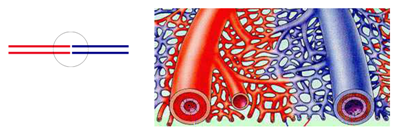 | Figure 4 |
Figure 5 demonstrates an imaginary diagram of the micro-capillary arterio-venous junction at normal situations and during micro-capillary dilatation. | Figure 5 |
The biologic circulatory activity which takes place within a short while after the cupping procedure can be referred to as “a highly selective pooling of the whole circulation within a localized sector of the capillary bed over a limited interval”. The pooling of the circulation is related to histamine release due to skin scratching, while fall of the undesired spherical red blood cells out of the circulation is due to the influence of endothelial-derived NO production leading to micro-capillary dilatation. In normal situations, the biconcave healthy red cells circulate through the micro-capillary bed smoothly from the arterial to the venous side, while the spherical unhealthy red cells have to get squeezed to the size of micro-capillaries in order to go through the narrow capillary bed under the influence of blood pressure. These cells recoil or regain their spherical shape after they pass beyond the narrow vessels. In case of micro-capillary dilation, the matter is not much different for the healthy cells whereas the unhealthy red cells undergo less squeeze to an ovoid oblong shape that recoils and gains a blunt-shaped distal end on reaching the dilated micro-capillary arterio-venous junction due to the influence of NO; therefore, these cells bulge and get stuck at the potential space of arterio-venous junction restoring most of their spherical shape, becoming unable to continue through the venous side of the micro-capillary and accordingly are obliged to fall into the interstitial space constituting the blood of the future cupping session [6, 7, 11]. Figure 6 demonstrates the imaginary flow of normal red blood cells in the capillary bed from the arterial to venous side.  | Figure 6 |
Figure 7 demonstrates the imaginary flow of the old spherical red cells in the capillary bed during normal situations where the cell gets compressed to an oblong shape then recoils and regains its spherical shape when it leaves the narrow vessels. | Figure 7 |
Figure 8 shows the imaginary flow of normal red blood cells in the capillary bed during micro-capillary dilatation. | Figure 8 |
Figure 9 demonstrates the imaginary flow of the old spherical red cells during micro-capillary dilatation where these cells recoil in the dilated arterio-venous junction and gain a blunt end that gets stuck at the venous side.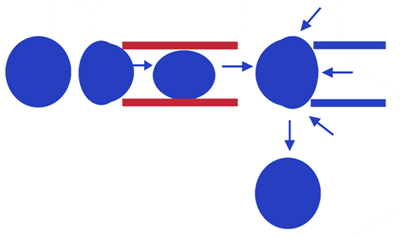 | Figure 9 |
Figure 10 demonstrates how the old spherical red cells could fall out of the circulation during micro-capillary dilatation induced due the effect of BLO cupping procedure.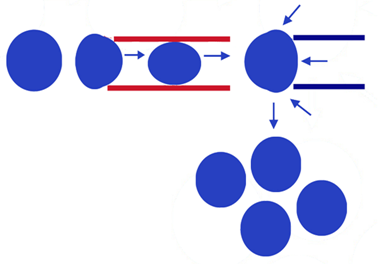 | Figure 10 |
Figure 11 demonstrates clearance of the circulation from its undesired blood into the interstitial spaces constituting the blood that would be let out during the future cupping therapy session.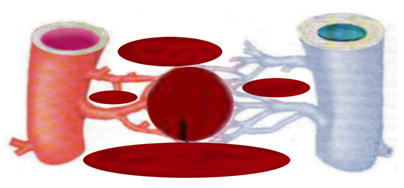 | Figure 11 |
Scratching in cupping procedures is minutely tiny and extremely superficial touching even no micro-capillaries and the blood trapped within the tissues moves towards the cups in response to the effect of suction. There always appears ecchymosed skin at the site of cupping suction which does not disappear after re-scratching of these ecchymosed areas and repeat suction denoting its congested nature within the micro-capillaries and further confirming that scratching in cupping procedures does not injure even micro-capillaries. More-over, this observation frankly indicates the useful influence of cupping suction on the micro-vascular endothelium leading to the valuable stimulation of the endothelial-derived NO liberation. NO is a smart biologic material inside the body, the challenge in the matter of NO is never its administration as the modern medicine can do like in employing Viagra with its hazards but the challenge is the selective approach of NO to the required specific targeted area which does exactly happen in cupping therapy [6, 7, 12, 13]. Figure 12 shows the ecchymosed area of the skin at the cups sites on the back denoting the congested state of the micro-capillaries due to the effect of repeated suction.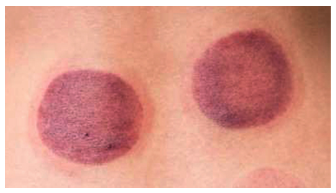 | Figure 12 |
The concept of “selective pooling of the circulation within a capillary bed compartment” explains the sense of sleepiness or dizziness that accompanies or directly follows cupping procedures due to attraction of the circulation towards the area of cupping confirming the biologic value of cupping therapy; same as the full stomach stealing the circulation for the purpose of the biologic digestive function and thus turning the person sleepy. It also illustrates that the maximum benefit of cupping therapy should be mainly expected during the interval immediately related to the cupping session that coincides with the short life of NO; therefore, the person should relax after cupping therapy for a couple of hours at least and gain energy from light diet and drinks which is required for the biological process exerted by the circulation avoiding steal of the circulation towards a full stomach by a big meal or to the muscles by doing un-necessary effort. This further conforms with the fact that liberation of NO is limited to a particular interval of time. The concept of the “selective localized pooling of circulation within the capillary bed in cupping therapy” gives the definite answer for those who employ too many therapeutic cups in one session causing undue scattering of the circulation, wasting the value of therapy and exhausting the patient for no much or even less benefit. It could also indicate in the mean time that the theories of the Chinese points of acupuncture and the hypothesis of the energy pathway lines in cupping therapy are not standing over solid scientific grounds as cupping therapy is letting-out of blood and its biologic value lies mainly in sero-clearance consequent to a highly selective pooling of the circulation within a localized capillary bed compartment. [4, 6, 11, 14, 15]The “concept of pooling of the circulation within a sector of the capillary bed” explains why cupping therapy should not be done for patients with sickle cell disease. Red blood cells that contain normal hemoglobin are disc shaped, this shape allows the cells to be flexible so that they can move through major, large, small and micro-capillary vessels to deliver oxygen to cells and tissues. While sickle hemoglobin is unlike normal hemoglobin as it can form stiff rods within the red cell changing it into a crescent or sickle shape; sickle-shaped cells are not flexible. As much as sickle cells can stick to the vessel wall and stick or cluster at micro-vascular bifurcations, they can further stick and cluster together at the sites of the NO-induced micro-capillary dilated synapses (junctions) causing a blockage that slows or stops the flow of blood, therefore; oxygen can not reach adjacent cells and tissues or these sickle cells could fall out of the circulation during “pooling of blood within a dilated capillary bed” that follows cupping therapy because of their abnormal shape and non-flexibility giving the signs and symptoms of sickle cell crisis. Sticking together of sickle cells could be also precipitated during “pooling of blood within the dilated capillary bed” due to a further reason which is dehiscence or change of hemodynamic aspects of blood while flowing within the dilated micro-capillaries leading to stasis or block of circulation. Accordingly, the theory of the “highly selective pooling of the circulation within a specific sector of the capillary bed over a limited interval” could be considered the most accepted concept in cupping as it explains the mechanism of sero-clearance in blood-let out cupping therapy and it can give the answer and explanation for most questions and queries in cupping therapy [11, 16, 17]. Figure 13 demonstrates how the sickle cells could get stuck at the micro-capillary junction during micro-capillary dilatation due to the effect of cupping.  | Figure 13 |
Figure 14 demonstrates how the sickle cells could cluster together at the micro-capillary junction during micro-capillary dilatation due to the effect of shear stress caused by repeated suction in cupping procedure.  | Figure 14 |
Figure 15 shows how the sickle cells could fall out of the circulation in case of dehiscence or change of hemo-dynamics during micro-capillary dilatation caused by the effect of cupping. | Figure 15 |
Sero-clearance is a huge biological talent which is not feasible via the available clinical measures except cupping therapy; it is an integral reason to augment the individual immunity allowing the body in turn to combat the progress of any chronic illness. That is how cupping therapy via sero-clearance can deplete the viral load to very low levels and that is how a patient with highly improved individual immunity due to the improved quality of oxygen and nutrient carrying capacity of blood can have the chance to overcome a viral illness in its very low or undetectable levels. The interstitial space, where a lot of biological processes exist, constitutes therefore the intelligent yard where BLO cupping therapy exerts its biological talents [4, 6, 11].
2. Conclusions
Cupping BLO therapy could constitute a therapeutic revolution via a huge biological process of sero-clearance leading to augmentation of individual immunity due to improvement of oxygen and nutrient carrying properties of blood together with diminution of the undesired elements in the circulation to extremely low or undetectable levels allowing the chance for clinical cure from major illness. The concept of the “highly selective pooling of the whole circulation within a localized sector of the capillary bed over a limited interval” during cupping procedures seems standing over solid scientific grounds. The interstitial space, where a lot of biological processes exist, constitutes the intelligent yard where BLO cupping therapy exerts its biological talents.As long the literature is lacking sufficient peer-reviewed knowledge in cupping therapy, this article might remain hypothetical just as a theory until it is approved or disapproved by future studies. However, this study is supported by adequate experimental and observational findings which could essentially strengthen any theoretical suggestion. This study may have the advantage of paving the way for researchers to lead further studies in the same field.
References
| [1] | Nasrat AM, Nasrat SAM, Nasrat RM, et al. Diabetic leg critical ischemia; early clinical detection and therapeutic cupping prophylaxis. Gen Med 2015; 3: 4. [Open Access] doi.org/10.4172/2327-5146.1000201. |
| [2] | Nasrat AM. It is neither re-implantation nor implantation, it is hair plantation. The International Congress of Aesthetic Dermatology, Bangkok, Thailand 2010 Jan. Available from URL, www.euromedicom.com. |
| [3] | Nasrat AM. Diabetic leg critical ischemia; early clinical detection and therapeutic cupping prophylaxis. The First American Diabetes Association Congress in the Middle East, Dubai 2012 Dec. Available from URL, www.ADA-me.org. |
| [4] | Nasrat AM, El-Sayed SM, Nasrat SA. Role of blood-let out cupping therapy in angina and angina risk management. Gen Med 2015; 3: 3. [Open Access] doi.org/10.4172/2327-5146.1000191. |
| [5] | Nasrat AM. Role of blood-let out cupping therapy in angina and angina risk management, emergency Vs elective. The 22nd International Scientific Session of Saudi Heart Association, Riyadh 2011 Feb. Available from URL, www.sha.org.sa. |
| [6] | Nasrat AM, Nasrat SAM, Nasrat RM, et al. Role of blood-let out cupping therapy in taming the wild hepatitis B Virus. Int J Recent Sci Res 2015 Jul; 6 (7): 5049-5051. |
| [7] | Nasrat AM. Role of blood-let out cupping therapy in taming the wild hepatitis B Virus. The International Congress of Aesthetic Dermatology and Preventive medicine, Paris 2010 Oct. Available from URL, www.euromedicom.com. |
| [8] | Nasrat AM. Role of blood-let out cupping therapy in female pelvic congestion syndrome. The Aesthetic Dermatology and Anti-Aging Medicine World Congress, Dubai 2010 Nov. Available from URL, www.euromedicom.com. |
| [9] | Nasrat AM, Nasrat SAM, Nasrat RM, et al. Role of blood-let out cupping therapy in female pelvic congestion syndrome. Gen Med 2015; S1: 3. [Open Access] doi.org/10.4172/2327-5146.1000S1-003. |
| [10] | Miroshita K (1972). The hidden truth behind cancer. San Francisco, George Oshawa Macrobiotic Foundation. |
| [11] | Nasrat AM, Nasrat RM, Nasrat MM. Hepatitis C virus; its eradication from the serum is just possible. Gen Med 2016; 4: 3. [Open Access] doi.org/10.4172/2327-5146.1000249. |
| [12] | Nasrat AM, Nasrat SAM, Nasrat RM, et al. The biology of combined colon clear and blood-let out cupping therapy in female health. Gen Med 2015; 3: 4. [Open Access] doi.org/10.4172/2327-5146.1000203. |
| [13] | Nasrat AM, Nasrat SAM, Nasrat RM, et al. Therapeutic effect of combined colon clear and cupping therapy on idiopathic skin pathology. Gen Med 2015; 3: 4. [Open Access] doi.org/10.4172/2327-5146.1000209. |
| [14] | Nasrat AM, Nasrat RM, Nasrat MM. New approach for the hidden reasons behind cervical disc pathology during late decades. Gen Med 2015; 3: 6. [Open Access] doi.org/10.4172/2327-5146.1000214. |
| [15] | Nasrat AM, Nasrat RM, Nasrat MM. A therapeutic answer for the controversy of insulin cardio-protection among dysglycemic patients. Gen Med 2015; 3: 6. [Open Access] doi.org/10.4172/2327-5146.1000216. |
| [16] | MacCallum RN, Lynch EC, Hellums JD, et al. Fragility of abnormal erythrocytes evaluated by response to shear stress. J Lab Clin Med 1975 Jan; 85 (1): 67-74. |
| [17] | Nasrat AM. An answer for the controversy of insulin cardioprotection in dysglycemia. The First American Diabetes Association Congress in the Middle East, Dubai 2012 Dec. Available from URL, www.ADA-me.org. |


















 Abstract
Abstract Reference
Reference Full-Text PDF
Full-Text PDF Full-text HTML
Full-text HTML